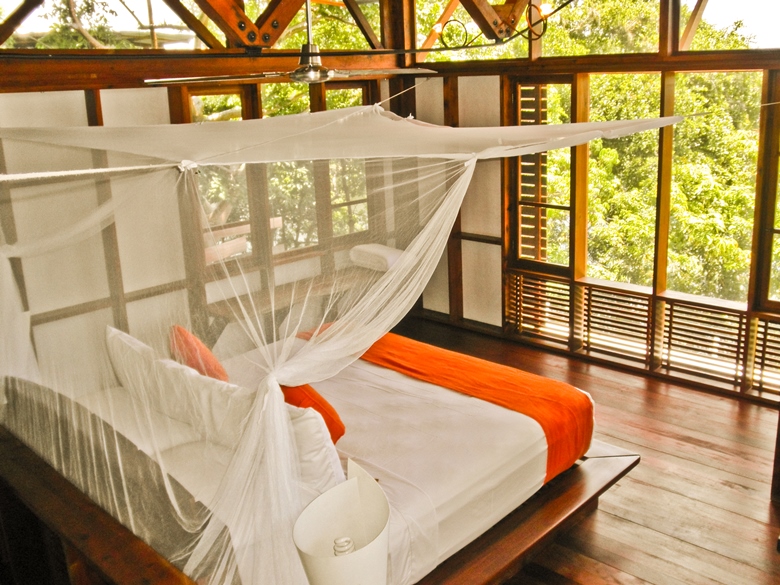Six days in Nicaragua, the next family eco-travel destination?


NICARAGUA — DAY ONE—I’m lying on a floating dock in Lake Nicaragua, the largest lake in Central America, talking to my daughter.
Nothing odd about that except this is the first real conversation we’ve had in months, since she graduated from college and came to Nicaragua for an internship—building an organic garden at an eco resort that could grow food for the resort’s restaurant.
After years of Taking the Kids, on this trip we’ve followed our 22-year-old daughter Melanie here to Nicaragua, which many say is poised to become the next eco tourist’s must-see destination with volcanoes, cloud forests, pristine beaches and tiny eco resorts like Jicaro Island Ecolodge, where we’re on a private island with just nine casitas, a 15 minute boat ride from the colonial city of Granada.
I love the resort’s sustainable practices, the hammock on the deck of our casita overlooking the lake, the open air kitchen and excursions to the nearby Mombacho Volcano.
For now, my husband and I are reveling in our daughter’s undivided attention—something we don’t enjoy very often. Truth be told, I’m glad her older brother and sister and their significant others couldn’t come. We’ll all gather at Christmas; this week is just about the three of us.
Jicaro is part of the Cayuga Collection of sustainable luxury hotels and lodges in Costa Rica and Nicaragua.
Nicaragua, many say, is where Costa Rica was two decades ago—pristine, with lots of beautiful beaches, volcanoes , the colonial city of Granada. It’s a little rough around the edges which makes it more of an adventure, though Jicaro is just as polished as a small resort anywhere. Many famous sites–the Masaya Craft Markets, the Mombacho Volcano, the isletas on Lake Nicaagua, are less than an hour away.
Let’s not forget relaxing!
“More and more people are discovering Nicaragua. It’s still virgin, less touristy and much less expensive than Costa Rica,” offered Remo Pere, the Swiss Manager of the 36-room Hotel Colonial that was built in the style of traditional houses here in the oldest Colonial City in the new world about an hour’s drive from Managua where we’d landed.
Rooms at his hotel—considered one of the best in the city—rooms including breakfast start at less than $100 a night.
President Daniel Ortega says he wants to use tourism to combat poverty and today tourism is the country’s second largest industry, with the country now welcoming over a million tourists annually.
This is a far cry from the 1980s during the Nicaraguan Revolution when Nicaragua was considered a place to stay away from with locals leaving for the United States and Costa Rica.
Now tourism is growing rapidly. It has one of the lowest crime rates in Latin America. American dollars are accepted everywhere. Just be prepared that as friendly and welcoming as Nicaraguans are, they typically don’t speak much English.
We spent our first morning touring Granada with Rene Mena, a young father of two and trained lawyer who says he much prefers the tourism business. Here is the beautiful Colon Park, learn a little Nicaraguan history, including the years of military dictatorship under Anastasio Somoza Debayle, who was overthrown in 1979.
We see the national tree of Nicaragua—the Madrono—whose fragrant white flowers decorate the churches during the Christmas holidays.
There is the stone-walled street—the natives lived on one side, the Spanish settlers the other where today bulls race down to Lake Nicaragua during an August festival in honor of the ‘Virgen de la Asunción’.
We climb to the top of the La Merced church up a narrow winding staircase to see the spectacular view—the cloud forest and the 5,200-mile lake.

The market is the most frenetic I’ve ever seen. There are few no tourists here, mainly locals buying and selling everything from rice and beans and meats to vegetables, fruit, sugar cane and papaya, clothes and shoes, communion dresses, coffee bens, plantains and cheese in giant hunks. Nicaraguans eat a lot of cheese, he tells ups. There’s rope, brooms and kids drinking sugary fruit drinks served up in plastic bags with a straw.

Especially after that experience, we appreciated the tranquility of Jicaro–the casitas overlooking the lake made out of Teak with sliding louvered doors, mosquito nets over the bed. We’re greeted with cold towels and a refreshing cold local drink. For lunch we enjoy ceviche, gazpacho, shrimp tacos and salad.
My husband settles into a hammock for a nap. We swim out to the floating dock in the lake and talk…and talk. It’s one of those vacation days I wish never ends.
